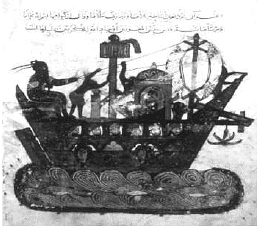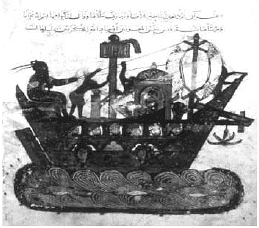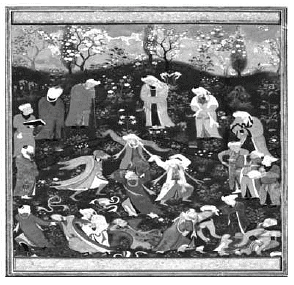Test: Central Islamic lands- Source Based Type Questions - 2 - UPSC MCQ
15 Questions MCQ Test Lucent for GK - Test: Central Islamic lands- Source Based Type Questions - 2
Read the following extract carefully and answer the following question by choosing the correct option:
The Hijri era was established during the caliphate of Umar with the first year falling 622 CE.
A date in the Hijri calendar is followed by the letters AH.
The Hijri year is a lunar year of 354 days, 12 months (Muharram to Dhul Hijja) of 29 or 30 days. Each day begins at Sunset and each month with the sighting of the Crescent moon. The Hijri year is about 11 days shorter than the Solar year. Therefore, none of the Islamic religious festivals, including the Ramazan fast, Id and Hajj, corresponds in any way to seasons. There is no easy way to match in the Hijri calendar with the dates in the Gregorian calendar. One can calculate the rough equivalents between the Islamic (H) and Gregorian Christian (C) years with the following formulae:
(H × 32/33) + 622 = C
(C – 622) × 33/ 32 = H
Q. When was the Hijri era established?
Read the following extract carefully and answer the following question by choosing the correct option:
The Hijri era was established during the caliphate of Umar with the first year falling 622 CE.
A date in the Hijri calendar is followed by the letters AH.
The Hijri year is a lunar year of 354 days, 12 months (Muharram to Dhul Hijja) of 29 or 30 days. Each day begins at Sunset and each month with the sighting of the Crescent moon. The Hijri year is about 11 days shorter than the Solar year. Therefore, none of the Islamic religious festivals, including the Ramazan fast, Id and Hajj, corresponds in any way to seasons. There is no easy way to match in the Hijri calendar with the dates in the Gregorian calendar. One can calculate the rough equivalents between the Islamic (H) and Gregorian Christian (C) years with the following formulae:
(H × 32/33) + 622 = C
(C – 622) × 33/ 32 = H
Q. What is the difference between Hijri year and Solar year?
| 1 Crore+ students have signed up on EduRev. Have you? Download the App |
Read the following extract carefully and answer the following question by choosing the correct option:
The Arabs were divided into tribes (qabila), each led by a chief who was chosen partly on the basis of his family connections but more for his personal courage, wisdom and generosity. Each tribe had its own God or Goddesses, who was worshipped as an idol in a Shrine. Many Arab tribes were Nomadic, moving from dry to Green areas of the desert in search of food (mainly dates) and fodder for their camels. Some settled in cities and practiced trade or agriculture. Muhammad’s own tribe Quraysh, lived in Mecca and controlled the main shrine there, a cube-like structure called Kaaba, in which idols were placed. Even tribes outside Mecca considered the Kaba Holy and installed their own idols at this shrine, making annual pilgrimage (Hajj) to the shrine. Mecca was located on the crossroads of a trade route between Yemen and Syria which further enhanced the city’s importance. The Meccan Shrine was a sanctuary (Haram) where violence was Forbidden and protection given to all visitors. Pilgrimage and Commerce gave the Nomadic and settled tribes an opportunity to communicate with one another and share their beliefs and Customs. Although the polytheistic Arabs were vaguely familiar with the notion of a Supreme God, Allah (possibly under the influence of the Jewish and Christian tribes living in their midst), their attachment to Idols and shrines was more immediate and stronger.
Q. According to the extract, what do you know about the main teaching of Islam?
(i) Idol worship is a curse.
(ii) God i.e., Allah is almighty.
(iii) Islam believe in life after death in hell or heaven.
(iv) No one is superior or inferior .
Read the following extract carefully and answer the following question by choosing the correct option:
The Arabs were divided into tribes (qabila), each led by a chief who was chosen partly on the basis of his family connections but more for his personal courage, wisdom and generosity. Each tribe had its own God or Goddesses, who was worshipped as an idol in a Shrine. Many Arab tribes were Nomadic, moving from dry to Green areas of the desert in search of food (mainly dates) and fodder for their camels. Some settled in cities and practiced trade or agriculture. Muhammad’s own tribe Quraysh, lived in Mecca and controlled the main shrine there, a cube-like structure called Kaaba, in which idols were placed. Even tribes outside Mecca considered the Kaba Holy and installed their own idols at this shrine, making annual pilgrimage (Hajj) to the shrine. Mecca was located on the crossroads of a trade route between Yemen and Syria which further enhanced the city’s importance. The Meccan Shrine was a sanctuary (Haram) where violence was Forbidden and protection given to all visitors. Pilgrimage and Commerce gave the Nomadic and settled tribes an opportunity to communicate with one another and share their beliefs and Customs. Although the polytheistic Arabs were vaguely familiar with the notion of a Supreme God, Allah (possibly under the influence of the Jewish and Christian tribes living in their midst), their attachment to Idols and shrines was more immediate and stronger.
Q. What do you know about the Arab tribe?
Read the following extract carefully and answer the following question by choosing the correct option:
The Arabs were divided into tribes (qabila), each led by a chief who was chosen partly on the basis of his family connections but more for his personal courage, wisdom and generosity. Each tribe had its own God or Goddesses, who was worshipped as an idol in a Shrine. Many Arab tribes were Nomadic, moving from dry to Green areas of the desert in search of food (mainly dates) and fodder for their camels. Some settled in cities and practiced trade or agriculture. Muhammad’s own tribe Quraysh, lived in Mecca and controlled the main shrine there, a cube-like structure called Kaaba, in which idols were placed. Even tribes outside Mecca considered the Kaba Holy and installed their own idols at this shrine, making annual pilgrimage (Hajj) to the shrine. Mecca was located on the crossroads of a trade route between Yemen and Syria which further enhanced the city’s importance. The Meccan Shrine was a sanctuary (Haram) where violence was Forbidden and protection given to all visitors. Pilgrimage and Commerce gave the Nomadic and settled tribes an opportunity to communicate with one another and share their beliefs and Customs. Although the polytheistic Arabs were vaguely familiar with the notion of a Supreme God, Allah (possibly under the influence of the Jewish and Christian tribes living in their midst), their attachment to Idols and shrines was more immediate and stronger.
Q. What do you think according to this extract is the meaning of Mecca?
Read the following extract carefully and answer the following question by choosing the correct option:
At the beginning of the 11th century Ghazni became the centre of Persian literary life. Poets were naturally attracted by the brilliance of the Imperial Court. Rulers, too, realised the importance of patronising Arts and learning for enhancing their prestige. Mahmud of Ghazni gathered around him a group of poets who composed anthologies (diwans) and Epic poetry (mathnawi). The most outstanding was Firdausi (d. 1020) who took 30 years to complete the Shahnama (Books of Kings), an epic of 50,000 couplets which has become a masterpiece of Islamic literature. The Shahnama is a collection of traditions and legends (the most popular being that of Rustam), which poetically depicts Iran from creation up until the Arab conquest.
How many years did it take to complete Shahnama?
Q. Name the outstanding work which took 30 years to complete.
Read the following extract carefully and answer the following question by choosing the correct option:
At the beginning of the 11th century Ghazni became the centre of Persian literary life. Poets were naturally attracted by the brilliance of the Imperial Court. Rulers, too, realised the importance of patronising Arts and learning for enhancing their prestige. Mahmud of Ghazni gathered around him a group of poets who composed anthologies (diwans) and Epic poetry (mathnawi). The most outstanding was Firdausi (d. 1020) who took 30 years to complete the Shahnama (Books of Kings), an epic of 50,000 couplets which has become a masterpiece of Islamic literature. The Shahnama is a collection of traditions and legends (the most popular being that of Rustam), which poetically depicts Iran from creation up until the Arab conquest.
How many years did it take to complete Shahnama?
Q. Which book is called the Book of Kings?
Read the following extract carefully and answer the following question by choosing the correct option:
At the beginning of the 11th century Ghazni became the centre of Persian literary life. Poets were naturally attracted by the brilliance of the Imperial Court. Rulers, too, realised the importance of patronising Arts and learning for enhancing their prestige. Mahmud of Ghazni gathered around him a group of poets who composed anthologies (diwans) and Epic poetry (mathnawi). The most outstanding was Firdausi (d. 1020) who took 30 years to complete the Shahnama (Books of Kings), an epic of 50,000 couplets which has become a masterpiece of Islamic literature. The Shahnama is a collection of traditions and legends (the most popular being that of Rustam), which poetically depicts Iran from creation up until the Arab conquest.
How many years did it take to complete Shahnama?
Q. Ghazni became the centre of literary life”, which of the following statements justifies it?
Study this picture from The Central Islamic Lands carefully and answer the following question by choosing the correct option:

Q. The crew and passengers shown in the pictures are:
Study this picture from The Central Islamic Lands carefully and answer the following question by choosing the correct option:

Q. The transport of goods and passengers by water was cheaper, quicker and safer.
Read the following extract carefully and answer the following question by choosing the correct option:
In medieval Islamic societies, Christians were regarded as the People of the Book (ahl al-kitab) since they had their own scripture (the New Testament or Injil). Christians were granted safe conduct while venturing into Muslim States as merchants, pilgrims, ambassadors and travellers. These territories also include those which were once held by the Byzantine Empire, notably the holy land of Palestine. Jerusalem was conquered by Arabs in 638 but it was ever present in the Christians imagination as the place of Jesus' crucifixion and resurrection. This was an important factor in the formation of the image of Muslim in Christian Europe.
Hostility towards the Muslim word become more pronounced in the 11th century. Normans, Hungarians and some Slavs had been converted into Christianity, and the Muslim alone remained as the main enemy. There was also a change in the social and economic organisation of Western Europe in the 11th century which contributed to the hostility between Christendom and the Islamic world.
Q. What kind of people Christians were regarded in medieval Islamic society?
Read the following extract carefully and answer the following question by choosing the correct option:
In medieval Islamic societies, Christians were regarded as the People of the Book (ahl al-kitab) since they had their own scripture (the New Testament or Injil). Christians were granted safe conduct while venturing into Muslim States as merchants, pilgrims, ambassadors and travellers. These territories also include those which were once held by the Byzantine Empire, notably the holy land of Palestine. Jerusalem was conquered by Arabs in 638 but it was ever present in the Christians imagination as the place of Jesus' crucifixion and resurrection. This was an important factor in the formation of the image of Muslim in Christian Europe.
Hostility towards the Muslim word become more pronounced in the 11th century. Normans, Hungarians and some Slavs had been converted into Christianity, and the Muslim alone remained as the main enemy. There was also a change in the social and economic organisation of Western Europe in the 11th century which contributed to the hostility between Christendom and the Islamic world.
Q. On the basis of the given passage, what do you know about Crusades?
Study this picture from The Central Islamic Lands carefully and answer the following question by choosing the correct option:

Q. What do you think the people shown in the picture are doing?
Study this picture from The Central Islamic Lands carefully and answer the following question by choosing the correct option:

Q. The above painting is on whirling dervishes’ Iranian manuscript.
Which of the following is NOT a correct option?
|
624 videos|779 docs|415 tests
|

















